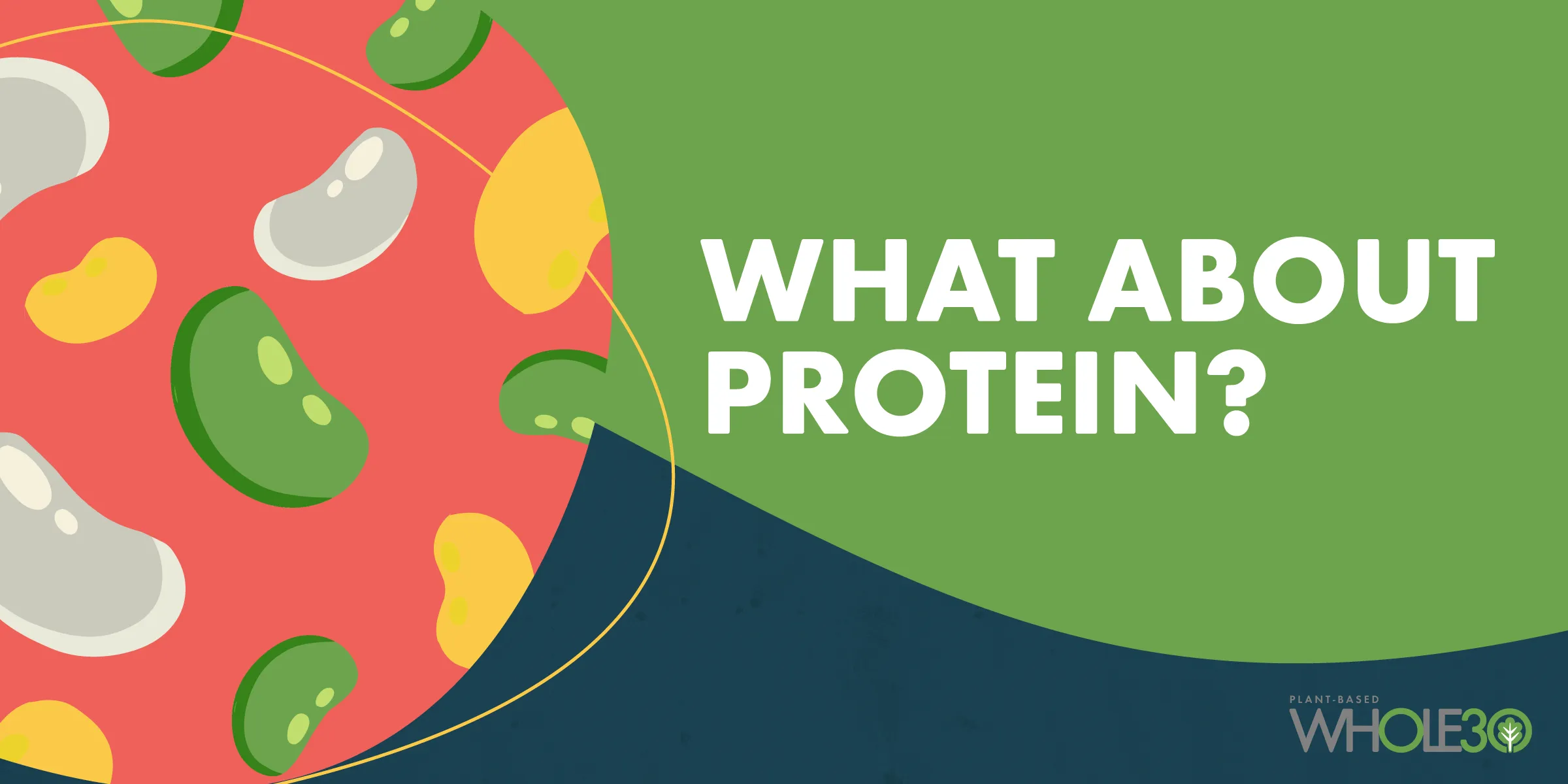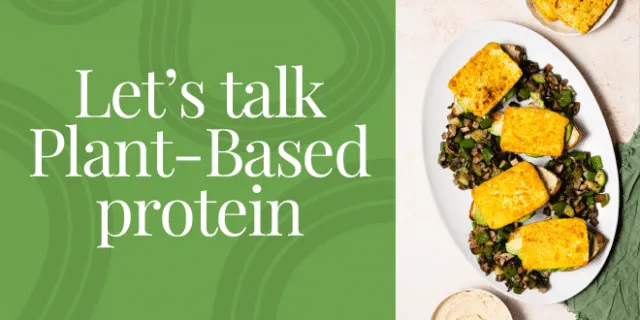Click here to download our Plant-Based Protein PDF
One of the most common questions about adopting a plant-based diet is, “Where do you get your protein?” It’s a valid question! With a 100% plant-based diet, you’re eliminating commonly recognized protein-rich foods like meat, fish, eggs, and dairy. However, many plant-based foods contain protein, and in our Plant-Based Whole30, we prioritize adequate protein intake and a healthy balance of essential amino acids from a variety of whole food sources.
Let’s break down some common myths regarding plant-based protein, and how you can meet your protein needs on the Plant-Based Whole30.
What are my protein options on the Plant-Based Whole30?
Our primary protein sources include legumes, lentils and peas; whole or minimally processed forms of soy like edamame, tofu, and tempeh; minimally processed meat alternatives such as Abbot’s Butcher “beef” and “chorizo;” and whole forms of plant-based protein powders like pea, hemp, pumpkin, or chia. Nuts and seeds provide additional protein to complement your main protein source(s) at meals.
Highly processed forms of soy, including textured soy protein, textured vegetable protein, soy protein isolate, soy protein concentrate, and highly processed soy-based meat alternatives are not compatible with the Plant-Based Whole30. The Plant-Based Whole30 also excludes all grains (like wheat, rye, barley, or oats) and pseudo-cereals (like quinoa or amaranth).
Will I get enough protein on the Plant-Based Whole30?
Unlike the Original Whole30, the Plant-Based Whole30 includes legumes, soy, peanuts, and lentils to help ensure that participants consume sufficient protein and a variety of essential amino acids.
The recommended dietary allowance of protein is 0.8 g/kg (about 0.36 g/lb) of bodyweight per day, or about 10-35% of your daily calories. This amounts to about 70 grams of protein per day for the average 150-pound adult.
We recommend participants eat four meals a day, aiming for a minimum of 15 grams of protein from one or more protein sources per meal, to ensure your protein needs are met.
Serving suggestions per meal to achieve >15 grams of protein include:
- 1 cup of cooked beans or lentils
- 4 to 6 ounces of whole, less processed soy (tempeh, tofu, edamame)
- Compatible plant-based protein powder (1 to 2 scoops), mixed into soups, stews, or curries; or a yogurt, chia pudding, or smoothie served as part of a meal
We recommend that you base each meal around a plant-based protein source; fill the rest of your plate with vegetables; add a serving of fruit as you choose; and add plant-based fats to satiety.
If a lower carbohydrate approach better suits your blood sugar goals, you can opt for the lower end of the range for legumes and lentils (½ cup) and then add other lower-carbohydrate protein-rich options like nuts, seeds, and soy to bump up your total intake.
Example:
- Salad with one cup of black beans = 15 grams of protein
- Salad with ½ cup of black beans + 1 oz of almonds + tahini dressing = 16 grams of protein
Note, the lower end of this protein range may meet the nutrient needs for sedentary individuals; however it is likely not adequate for athletes and individuals with higher protein needs.
How can an athlete or someone with higher needs get enough protein on the Plant-Based Whole30?
Active individuals typically require protein in amounts closer to 1.2-1.8 g/kg of bodyweight per day. Because plant-based proteins have a lower digestibility than animal protein, shooting for a minimum of 1 g/kg (0.45 g/lb) of bodyweight can better support satiety, along with muscle and tissue maintenance and repair.
This means you’ll likely need to include a compatible protein powder at least once a day (see below for our protein powder recommendations), and shoot for the higher range of plant-based protein sources at meals. This looks like 1 cup of legumes or lentils or 6-7 oz of tofu or tempeh at meals, along with higher protein nuts and seeds (See our Protein Table for more information).
One amino acid you’ll want to pay special attention to is leucine. Leucine is needed for optimal protein synthesis (the growth and repair of muscle tissue) and without careful consideration, can be hard to get enough of on a plant-based diet. The latest research suggests that about 2 grams of leucine (ideally at each meal) is needed to support muscle recovery.
In a plant-based context, the best sources of leucine are extra firm or super firm tofu, tempeh, edamame, lentils, red kidney beans, and unsweetened plant-based protein powder. By consuming leucine-rich foods at each meal and filling in the gaps (as needed) with supplementation, you can reach your leucine needs.
Average leucine amounts per ½ cup:
- Extra firm tofu: 1.3 grams
- Tempeh: 1.2 grams
- Edamame: 0.6 grams
- Lentils: 0.6 grams
- Kidney beans: 0.6 grams
Unsweetened protein powder varies by brand and product. For example, Whole30 Approved Sprout Living’s Epic Protein contains 2.23 grams of leucine per serving, and offers a complete amino acid profile.
Does the Plant-Based Whole30 template provide enough complimentary protein and essential amino acids?
There is much confusion when it comes to plant-based protein and amino acid needs. Let’s first describe some basic terms.
Amino acids: The building blocks of protein; all living beings contain the same 20 amino acids.
Essential amino acids: Amino acids that cannot be produced by our bodies, and must be obtained from food. The 9 essential amino acids are histidine, leucine, isoleucine, lysine, methionine, phenylalanine, threonine, tryptophan, and valine.
Non-essential amino acids: The remaining 11 amino acids can be synthesized from other amino acids in the body.
Complete protein: Indicates this protein source contains all of the essential amino acids.
Incomplete protein: Indicates the quality of one or more of the essential amino acids in this particular food is lower than what’s considered “optimal.”
One commonly heard concern is that plant-based proteins are missing specific essential amino acids, which makes them incomplete sources of protein. However, we now have evidence that all plant foods contain all nine essential amino acids–perhaps just not enough to be considered “complete.” As long as an individual is eating a variety of plant-based protein sources (especially complete sources like soy, pea, and hemp) they will consume all of the essential amino acids in adequate quantities. (The one exception may be lysine, which can be harder to get in optimal amounts. However, lysine is found in beans, lentils, tempeh, and tofu–all protein sources that are prioritized on the Plant-Based Whole30.)
This article from Today’s Dietitian breaks these concepts down in even more detail.
Do I have to eat complementary proteins with each meal?
Contrary to what was once thought, you don’t have to eat complimentary protein sources (like chickpeas + tahini) with every meal. Just focus on a variety of protein sources throughout the day and week throughout the course of your program. and you’ll get what you need. The Plant-Based Whole30 framework also offers several complete sources of protein, such as soy, peas, pea protein, hemp, and chia.
Can I get enough protein while still regulating my blood sugar in a healthy way?
Yes. In fact, that’s a big part of why this program eliminates all grains, including pseudo-cereals like quinoa, amaranth, and buckwheat. While some people thrive on a higher carbohydrate plant-based diet, new evidence suggests that upwards of 88% of American adults are not meeting clinical health metrics that define optimal metabolic health.
In order to provide a blood sugar stabilizing plant-based protocol that meets the needs of a wide variety of individuals, grains are not part of the program during the 30-day elimination period. Legumes and lentils can instead be consumed with vegetables and fruit, nuts, and seeds–foods with a lower glycemic load.
At the end of the 30-day elimination period you’ll reintroduce grains in all forms, and can then evaluate how well you perform on a diet that contains higher carbohydrate foods like wheat, rice, oats, or quinoa.
Is Whole30 moving away from recommending animal protein?
No, the Whole30 isn’t moving away from recommending animal protein. The Original Whole30 still remains a discrete, practitioner-endorsed program and the best option for those who choose to include animal protein in their diet. (And our medical advisory board still believes that animal protein can be a healthy addition to many people’s diets.) The Plant-Based Whole30 seeks to expand the Whole30 framework, community, and benefits to individuals who choose to follow a plant-based, vegetarian, or vegan diet and are looking to reset their health, habits, and relationship with food.
Should I take supplements to support my protein intake?
Before taking any supplements, we recommend that you talk to your healthcare provider to make sure it’s a good fit for your unique situation. While some plant-based athletes find it helpful to include supplements like branch chain amino acids (BCAAs) and creatine to support their muscle building goals, it’s not required.
Unsweetened compatible protein powders, especially ones that offer more “complete” plant-based protein sources like pea protein or blends of plant-based proteins, can be an option for those who are strength training and want to ensure they can keep (and build) more muscle. Sprout Living’s Epic Protein, for example, may be a good compatible option for you to incorporate around your workouts. It offers a complete amino acid profile and provides more of a whole food source of concentrated BCAAs.
If you use creatine or BCAAs as part of your fitness regimen, check the label to ensure compatibility. Powders are generally a better option, as capsules are sometimes made with animal-sourced gelatin, but be on the lookout for added sugar (including stevia or artificial sweeteners) and other off-plan ingredients.
How can I use protein powders on the Plant-Based Whole30?
Unsweetened plant-based protein powder is allowed on the Plant-Based Whole30 as an option for those who have a hard time digesting legumes and lentils, or who have higher protein needs. This allows individuals to ensure sufficient protein in a form that’s easier on their digestive tract, especially if they are new to a plant-based diet.
Unflavored protein powder can be used in soups, stews, and mixed into dishes that have a liquid component like curries. This keeps the addition of plant-based protein powder more whole food-based. Smoothies and chia pudding recipes that use protein powder can also be utilized, although they should be lower in sugar and not resemble a dessert, and smoothies are meant to be eaten with meals, not replace them. (See this article for more guidance on smoothies.)
Protein powders are not necessary to complete the Plant-Based Whole30; they’re simply another option to help people meet their protein needs.
What protein powders are compatible?
Read the labels of your plant-based protein powder carefully, as most include non-compatible ingredients such as quinoa, rice, or sugar alternatives and sweeteners like stevia, monk fruit, or sucralose. See our Sneaky Sugars download for the various ways that sugar can show up on labels.
We have several Whole30 Approved partners with products that fit the Plant-Based Whole30, including Sprout Living Simple Protein and Nutiva Organic Hemp Seed Protein. There are other compatible options from brands such as Complement (a mix of almond, chia, pumpkin, sunflower, and pea protein) and NOW Foods pea protein.
Wondering how to create a Plant-Based Whole30 meal plan that meets your protein needs? Check out our Plant-Based Whole30 Prep Pack, with 3 exclusive recipes, the Plant-Based Whole30 Rules, and other helpful resources to help you maximize Whole30 success.
Some of the links in this article are affiliate links. We make a small commission off purchases made via our unique link. Thank you for supporting Whole30 and our partners.

















